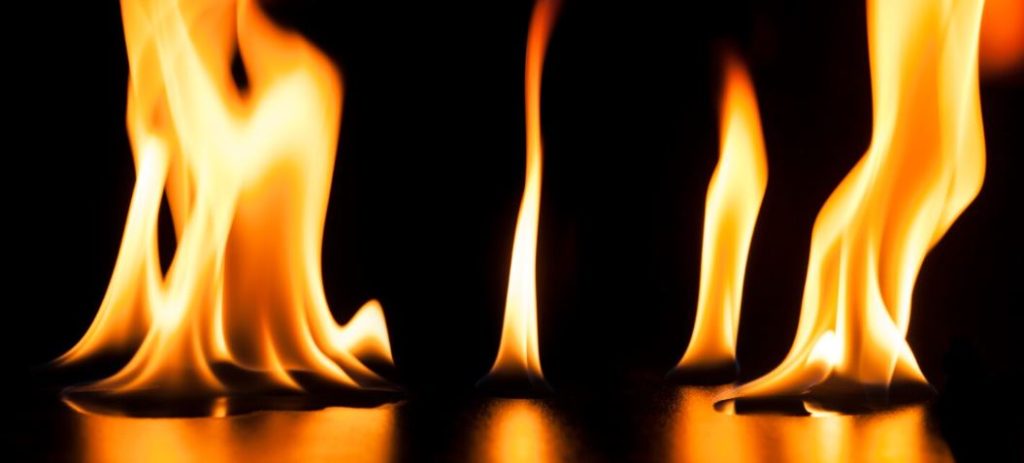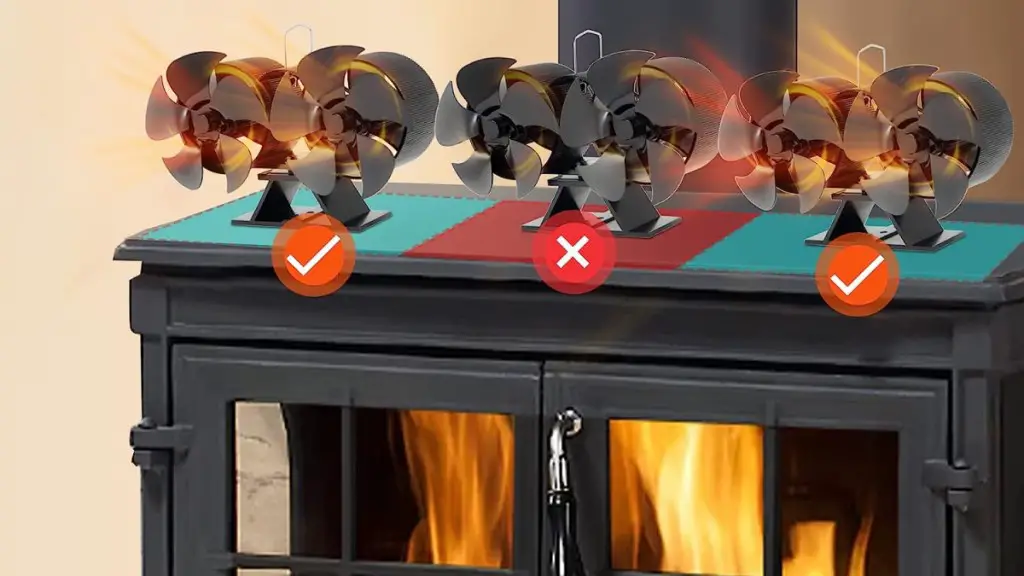Fireplaces are a cozy addition to any home, but they can also be a significant source of energy waste. According to Energy.gov, traditional fireplaces can lose up to 90% of their heat energy through the chimney. Fortunately, there are several ways to improve the efficiency of a fireplace and reduce energy waste.
One way to improve fireplace efficiency is to use the right kind of wood. Dry, seasoned hardwoods like oak, maple, and ash burn hotter and longer than softer woods like pine or spruce. This means they produce more heat and require less frequent refueling. It’s also important to store firewood in a dry, covered area to prevent it from absorbing moisture, which can decrease its heat output and create more smoke.
Page Contents
Understanding Fireplace Efficiency

Fireplaces are a popular feature in many homes, but they can be notoriously inefficient. Understanding fireplace efficiency is key to improving the performance of your fireplace and reducing energy waste. This section will explore the key factors that affect fireplace efficiency, including energy and heat loss, combustion efficiency, airflow, and drafts.
Energy and Heat Loss
Fireplaces are notorious for their poor energy efficiency. In fact, traditional open-hearth fireplaces can be as little as 10% efficient, meaning that up to 90% of the heat produced is lost through the chimney. This is due to a combination of factors, including the design of the fireplace, the type of fuel used, and the way the fire is managed.
One of the biggest factors affecting energy loss is heat loss. Heat loss occurs when heat is transferred from the fire to the surrounding air, and then escapes through the chimney. This can be minimized by using a fireplace insert or by installing tempered glass doors, which can help to trap heat and prevent it from escaping.
Combustion Efficiency
Combustion efficiency is another key factor that affects fireplace efficiency. Combustion is the process by which fuel is burned to produce heat. The efficiency of this process is affected by a number of factors, including the type of fuel used, the design of the fireplace, and the way the fire is managed.
One way to improve combustion efficiency is by using dry, seasoned wood. Wet or green wood can produce more smoke and creosote, which can reduce the efficiency of the fire and increase the risk of chimney fires. Another way to improve combustion efficiency is by using a fireplace insert or a wood stove, which can help to direct heat into the room and reduce heat loss.
Airflow and Drafts
Airflow and drafts are also important factors that affect fireplace efficiency. Airflow refers to the movement of air through the fireplace and chimney, while drafts refer to the movement of air through the room. Both can affect the efficiency of the fire and the amount of heat that is produced.
One way to improve airflow is by using a damper to control the amount of air that enters the fireplace. This can help to regulate the temperature of the fire and reduce heat loss. Another way to improve airflow is by ensuring that the chimney is clean and free of obstructions, such as creosote or debris.
Drafts can be minimized by sealing any gaps or cracks in the fireplace or chimney. This can help to prevent cold air from entering the room and reduce heat loss. Additionally, using a fireplace insert or a wood stove can help to direct heat into the room and reduce the impact of drafts.
Improving fireplace efficiency requires a combination of factors, including using the right fuel, managing the fire effectively, and ensuring proper airflow and draft control. By taking these steps, homeowners can reduce energy waste and enjoy a more efficient and effective fireplace.

Improving Efficiency of Existing Fireplace
Improving the efficiency of an existing fireplace is a great way to reduce energy costs and increase the warmth and comfort of a home. Here are some tips for improving the efficiency of an existing fireplace.
Use of Fireplace Doors
Installing fireplace doors is a great way to improve the efficiency of an existing fireplace. Fireplace doors help to prevent heat loss by keeping warm air inside the room and preventing cold air from entering. They also help to prevent sparks and embers from escaping the fireplace and causing a fire.
Proper Use of Damper
The damper is a crucial component of a fireplace. It helps to regulate the flow of air and smoke through the chimney. Proper use of the damper can help to improve the efficiency of an existing fireplace. When the fireplace is not in use, the damper should be closed to prevent cold air from entering the home. When the fireplace is in use, the damper should be opened to allow smoke and gases to escape through the chimney.
Regular Cleaning and Maintenance
Regular cleaning and maintenance of an existing fireplace is essential to improve its efficiency. Soot and creosote build-up can reduce the efficiency of a fireplace by blocking the flow of air and gases. Regular cleaning can help to remove these build-ups and improve the efficiency of the fireplace. It is recommended to have a professional chimney sweep clean and inspect the fireplace at least once a year.
In conclusion, improving the efficiency of an existing fireplace can be achieved by installing fireplace doors, proper use of the damper, and regular cleaning and maintenance. These simple steps can help to reduce energy costs and increase the warmth and comfort of a home.

Fireplace Inserts and Their Efficiency
Fireplace inserts are a popular option for homeowners looking to increase the efficiency of their fireplaces. They are designed to fit into existing masonry fireplaces and can greatly improve heat output while reducing the amount of heat lost up the chimney.
Wood Stove Inserts
Wood stove inserts are a type of fireplace insert that burn wood logs. They typically have a metal shell that surrounds the firebox and a glass door that allows you to see the flames. Wood stove inserts are highly efficient and can provide up to 80% efficiency compared to traditional open fireplaces. They also produce less smoke and particulate matter, making them a more environmentally-friendly option.
When choosing a wood stove insert, it’s important to consider the size of your fireplace and the heating needs of your home. A professional installer can help you choose the right size and model for your needs.
Gas Inserts
Gas inserts are another type of fireplace insert that burn natural gas or propane. They are easy to use and require no wood, making them a convenient option for homeowners. Gas inserts are highly efficient and can provide up to 90% efficiency compared to traditional open fireplaces. They also produce less pollution and require less maintenance than wood stove inserts.
When choosing a gas insert, it’s important to consider the size of your fireplace and the type of gas you have available. Natural gas is typically less expensive than propane, but propane may be a better option if natural gas is not available in your area.
Overall, both wood stove inserts and gas inserts can greatly improve the efficiency of your fireplace and reduce your heating costs. It’s important to choose the right type and size for your needs and have it professionally installed to ensure optimal performance.

Choosing the Right Fuel
When it comes to improving fireplace efficiency, choosing the right fuel is essential. There are several factors to consider when selecting the best fuel for your fireplace, including the type of wood, moisture content, and whether it is seasoned or green.
Hardwood Vs Softwood
One of the first things to consider when selecting the right fuel for your fireplace is whether to use hardwood or softwood. Hardwood, such as oak or maple, is denser and burns longer and hotter than softwood, such as pine or cedar. Softwood, on the other hand, ignites more quickly and produces less ash.
Moisture Content in Wood
Another important factor to consider is the moisture content of the wood. Burning wet or green wood can result in a smoky fire that produces less heat and more creosote buildup in the chimney. It is recommended to use wood with a moisture content of 20% or less.
Seasoned Firewood Vs Green Wood
Seasoned firewood is wood that has been cut and allowed to dry for at least six months, while green wood is freshly cut. Seasoned firewood burns more efficiently and produces less smoke and creosote buildup than green wood. It is recommended to use seasoned firewood for the best fireplace efficiency.
In summary, choosing the right fuel for your fireplace is a crucial step in improving its efficiency. Hardwood burns longer and hotter but produces more ash, while softwood ignites more quickly and produces less ash. Burning dry, seasoned firewood with a moisture content of 20% or less will result in a more efficient and cleaner-burning fire.
Safety Measures and Precautions
When using a fireplace, it is important to take necessary safety measures and precautions to prevent any potential hazards. Here are some tips to keep in mind:

Regular Inspection of Chimney
Regular inspections of the chimney can help prevent chimney fires and ensure that the fireplace is functioning efficiently. A professional chimney sweep should be hired to inspect and clean the chimney at least once a year. This will help remove any debris, creosote, or other blockages that may have accumulated in the chimney.
Proper Ventilation
Proper ventilation is crucial when using a fireplace. Make sure that the air vents in the room are open to allow fresh air to circulate. This will help prevent the build-up of carbon monoxide and other harmful gases. It is also important to keep the damper open while the fire is burning to ensure that smoke and gases are properly vented out of the chimney.
Avoiding Creosote Build-up
Creosote is a byproduct of burning wood that can accumulate in the chimney and cause a fire. To avoid creosote build-up, it is important to burn only dry, seasoned wood that has been properly stored. Wet or green wood can produce more creosote and should be avoided. Additionally, it is important to avoid burning paper, cardboard, or other materials that can produce excess creosote.
In summary, taking proper safety measures and precautions when using a fireplace is essential to prevent potential hazards. Proper ventilation, regular inspections of the chimney, and avoiding creosote build-up are all important steps to ensure the safe and efficient use of a fireplace.

Advanced Techniques to Improve Efficiency
Fireplaces can provide warmth and comfort to any home, but they can also be inefficient and costly to operate. Fortunately, there are advanced techniques that can improve the efficiency of a fireplace and reduce heating costs. Here are some techniques that homeowners can consider:
Use of Heat Exchanger
A heat exchanger is a device that captures the heat produced by a fireplace and transfers it to the room air. This can significantly improve the efficiency of a fireplace by preventing the heat from escaping through the chimney. Heat exchangers can be installed in existing fireplaces and come in a variety of styles and sizes.
When considering a heat exchanger, homeowners should look for models that are made from high-quality materials and are designed to fit their fireplace. They should also ensure that the heat exchanger is installed correctly to maximize its efficiency.
Installation of Stainless Steel Liner
A stainless steel liner is a protective and insulating layer that is installed inside the chimney. It can help to prevent heat loss and improve the efficiency of a fireplace. Stainless steel liners are easy to install and can be customized to fit any chimney size.
When installing a stainless steel liner, homeowners should ensure that it is installed correctly to prevent any leaks or drafts. They should also look for models that are made from high-quality materials to ensure that they last for many years.
Use of Built-In Fan
A built-in fan is a device that circulates the warm air produced by a fireplace throughout the room. It can help to improve the efficiency of a fireplace by distributing the heat more evenly. Built-in fans are available in a variety of styles and sizes and can be installed in existing fireplaces.
When considering a built-in fan, homeowners should look for models that are designed to fit their fireplace and are made from high-quality materials. They should also ensure that the fan is installed correctly to maximize its efficiency.
In conclusion, homeowners can improve the efficiency of their fireplaces by using advanced techniques such as heat exchangers, stainless steel liners, and built-in fans. These techniques can help to reduce heating costs and provide a more comfortable living environment.
Frequently Asked Questions
What are some tips for getting more heat from an open fireplace?
One of the best ways to get more heat from an open fireplace is to install a fireplace insert. A fireplace insert is a device that fits into your existing fireplace and helps to increase its efficiency by trapping heat and preventing it from escaping up the chimney. Another tip is to use a fireplace grate, which can help to improve airflow and increase the amount of heat that is produced.
Are there any tricks to making a wood burning fireplace more efficient?
Yes, there are several tricks to making a wood burning fireplace more efficient. One of the most important things you can do is to use dry, seasoned wood. Wet or green wood can create more smoke and produce less heat. Another tip is to keep the damper open when you are burning wood, as this can help to improve airflow and increase the amount of heat that is produced.
How can I keep heat from escaping up the chimney?
One way to keep heat from escaping up the chimney is to install a chimney cap. A chimney cap is a device that fits over the top of your chimney and helps to prevent heat from escaping. Another tip is to close the damper when the fireplace is not in use, as this can help to prevent heat from escaping up the chimney.
What are some ways to make an open fireplace more efficient?
One way to make an open fireplace more efficient is to install glass doors. Glass doors can help to trap heat and prevent it from escaping up the chimney. Another tip is to use a fireplace insert, which can help to increase the efficiency of your fireplace by trapping heat and preventing it from escaping. Finally, using a fireplace grate can help to improve airflow and increase the amount of heat that is produced.

